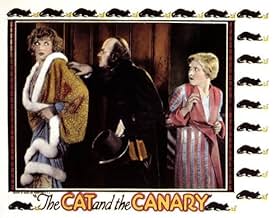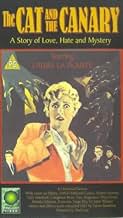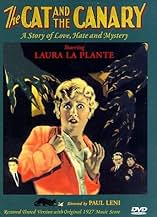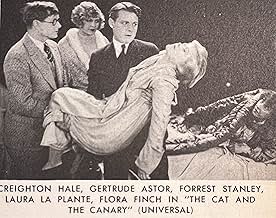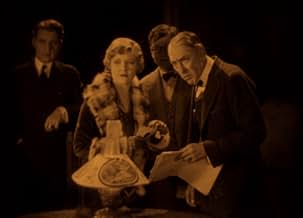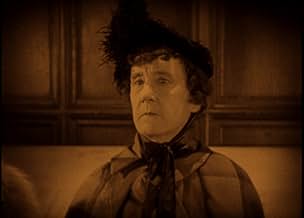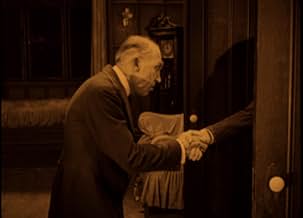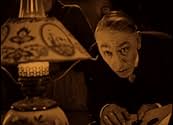CALIFICACIÓN DE IMDb
7.1/10
3.7 k
TU CALIFICACIÓN
Agrega una trama en tu idiomaRelatives of an eccentric millionaire gather in his spooky mansion on the 20th anniversary of his death for the reading of his will.Relatives of an eccentric millionaire gather in his spooky mansion on the 20th anniversary of his death for the reading of his will.Relatives of an eccentric millionaire gather in his spooky mansion on the 20th anniversary of his death for the reading of his will.
- Dirección
- Guionistas
- Elenco
- Premios
- 1 premio ganado en total
Arthur Edmund Carewe
- Harry Blythe
- (as Arthur Edmund Carew)
Billy Engle
- Taxi Driver
- (sin créditos)
Joe Murphy
- Milkman
- (sin créditos)
Opiniones destacadas
This late silent movie shows off the considerable talents of its director, Paul Leni, as the camera prowls the environs of an old dark house with the gracefulness of a cat, while the actors bob around like canaries, forming uneasy alliances and plotting against one another. The cast is well chosen. Laura La Plante makes a lovely heroine, while bespectacled Creighton Hale makes an agreeable, somewhat Harold Lloyd-like hero. Tully Marshall and Martha Mattox represent, none too flatteringly, the older generation; the former has the face of a drawn, white prune, while the latter makes a perfect battle-axe as the ironically named Mammy Pleasant. By today's standards the movie isn't too scary, though its mood of foreboding is still effective. Its qualities are pictorial more than dramatic, and the print I saw was badly in need of restoration.
The Cat and the Canary is a key film of the silent era, and was hugely influential in kicking off the old dark house genre that continued into the early talkie period. When sound came in the wisecracks proliferated, which tended to lighten the mood and detract from the suspense. In this one the humor is visual, and the tone is more consistent. There have been dozens remakes and imitations over the years, but the dark, Gothic beauty of the original has never been surpassed.
The Cat and the Canary is a key film of the silent era, and was hugely influential in kicking off the old dark house genre that continued into the early talkie period. When sound came in the wisecracks proliferated, which tended to lighten the mood and detract from the suspense. In this one the humor is visual, and the tone is more consistent. There have been dozens remakes and imitations over the years, but the dark, Gothic beauty of the original has never been surpassed.
Whether you take it as a good-natured send-up of the 'old dark house' genre, or simply as a semi-serious horror/comedy, either way "The Cat and the Canary" is good entertainment. The atmosphere in the dusty old mansion is done very well, with plenty of creativity, and the story moves at a good pace and is told well. These are more than enough to make up for a few plot holes and a couple of characters that are left undeveloped.
The cat/canary image, which was deliberately exaggerated somewhat, is simple but it ties the story and characters together rather well. Most of the characters are interesting, although a couple of them never really take shape. Most of the performers seemed to enjoy their roles, and they worked well together, with most of them making good use of their moments in the spotlight.
If you enjoy silent movies, you should find this a pleasant way to spend an hour and a half or so.
The cat/canary image, which was deliberately exaggerated somewhat, is simple but it ties the story and characters together rather well. Most of the characters are interesting, although a couple of them never really take shape. Most of the performers seemed to enjoy their roles, and they worked well together, with most of them making good use of their moments in the spotlight.
If you enjoy silent movies, you should find this a pleasant way to spend an hour and a half or so.
I'm a fan of both horror films and silent films, but I didn't have a chance to get around to this one until now--and I was surprised by how much I enjoyed it. Other reviewers have already indicated how well-directed it is, and some have pointed out that the "overacting" is intentional in what was always understood by 1927 audiences as a spoof of the "Old Dark House" genre that was popular on Broadway for much of the decade and spilled onto the movie screen. Once you understand that everyone KNEW these were cliches, you realize there's no reason to take a patronizing attitude. I have to say this is the most satisfying "ODH" film I've seen (not considering actual haunted house films like the first version of "The Haunting"). It has a light touch and almost every shot makes some delightful choice--moving camera, jarring close-up, dutch angle, etc. Director Leni succeeds in making this stage play seem cinematic. One shot has a frightened character speeding through the corridor, apparently on an unseen bicycle! The shot of the body falling down out of a closet onto the camera has been much imitated, both seriously (as in "Public Enemy") and as parody (Warner Bros. cartoons). For a quick comparison, check Roland West's early talkie "The Bat Whispers." Although nothing in "Cat" reaches quite the level of West's most astonishing shots, the film as a whole is more satisfying and less stagey.
This is one eerie movie. That it is over 75 years old shouldn't detract from its place among "scary movies." The production values are scrumptious. The acting is a bit over the top (Aunt Susan) but all in all, an eerie night with shadows and interesting interplay among the characters. But the Paul/Annabelle relationship is a bit creepy. Aren't they (gasp!) cousins????? The hairy hand is a bit over the top too. Mammy Pleasant (is her name an inside joke?) is waaay too menacing. I saw this on TMC (loved the sepia tone) and the soundtrack is exhilarating, though a tad too fast for the action. This is a gem of a horror movie.
I've read other user comments on this film, and I want to add my own. "The Cat and The Canary" is one of those films that is often spoken about as being one of the classic horror films of the silent era, and after watching this film it is easy to see why.
From the opening sequence, of a hand brushing away dust and cobwebs to reveal the films title, to the closing shot, the film is very spooky. Yes, I will say that at times the film is almost too spooky, and that some of the acting is overdone.
The plot of the film is simple: 20 years after a wealthy and thought to be insane man has died, his family gathers to read the contents of his will.
Those who see this film will see all types of cliches in the horror movie genre, hidden panels, hands reaching out from behind walls, creepy shadows, but the interesting thing to note is that this film was among the first to use these effects, in other words you are seeing these things occur before they became commonplace.
This was an early horror film made by Universal Pictures, fresh on the success of other classic Universal horror films like Phantom of the Opera and Hunchback of Notre Dame.
The director of this film, Paul Leni, was German, and the film directly relates that. This film is a classic example of how German filmmaking influenced American films. If you like this film, and especially the camera style, stylish sets, and the general modd and feel of the film, take a look at other German silent films, and you will love them as well.
This film is now Public Domain, and is available on DVD and VHS from several companies. IMDB lists its length in the 80 minute range, however the version I saw, with a new score is 101 minutes long. I highly reccomend this film.
From the opening sequence, of a hand brushing away dust and cobwebs to reveal the films title, to the closing shot, the film is very spooky. Yes, I will say that at times the film is almost too spooky, and that some of the acting is overdone.
The plot of the film is simple: 20 years after a wealthy and thought to be insane man has died, his family gathers to read the contents of his will.
Those who see this film will see all types of cliches in the horror movie genre, hidden panels, hands reaching out from behind walls, creepy shadows, but the interesting thing to note is that this film was among the first to use these effects, in other words you are seeing these things occur before they became commonplace.
This was an early horror film made by Universal Pictures, fresh on the success of other classic Universal horror films like Phantom of the Opera and Hunchback of Notre Dame.
The director of this film, Paul Leni, was German, and the film directly relates that. This film is a classic example of how German filmmaking influenced American films. If you like this film, and especially the camera style, stylish sets, and the general modd and feel of the film, take a look at other German silent films, and you will love them as well.
This film is now Public Domain, and is available on DVD and VHS from several companies. IMDB lists its length in the 80 minute range, however the version I saw, with a new score is 101 minutes long. I highly reccomend this film.
¿Sabías que…?
- TriviaWriter/director Robert F. Hill not only wrote the adaptation for this film but also served as a sort of assistant/associate director for Paul Leni. Leni, a German, didn't speak much English, and Hill spoke German, so he acted as a liaison between Leni and the cast and crew.
- ErroresAs Tully Marshall's dead body falls to the floor, the actor can be clearly seen extending his hands to break the fall.
- Citas
Roger Crosby: I have come to read the will of Cyrus West. Have any of the heirs arrived yet?
Mammy Pleasant: No, Mr. Crosby.
Roger Crosby: You must have been lonely here these twenty years, Mammy Pleasant.
Mammy Pleasant: I don't need the living ones.
- Créditos curiososThe ending cast list includes the following statement: "This is repeated at the request of picture patrons who desire to check the names of those players whose work has pleased them."
- Versiones alternativasKino International distributed a video with the original 1927 musical setting compiled by James Bradford and adapted and performed by Eric Beheim and "The Cyrus West Players." It was produced by David Shepard using film materials from the David Bradley collection, and copyrighted in 1997 by Film Preservation Associates. The running time was 82 minutes.
- ConexionesEdited into Histoire(s) du cinéma: Seul le cinéma (1994)
- Bandas sonorasSymphony No. 3 in C minor Op. 78 'Organ' I. Adagio
Written by Camille Saint-Saëns
Selecciones populares
Inicia sesión para calificar y agrega a la lista de videos para obtener recomendaciones personalizadas
- How long is The Cat and the Canary?Con tecnología de Alexa
Detalles
- Fecha de lanzamiento
- País de origen
- Idiomas
- También se conoce como
- The Cat and the Canary
- Locaciones de filmación
- Productora
- Ver más créditos de la compañía en IMDbPro
Taquilla
- Total en EE. UU. y Canadá
- USD 709,699
- Tiempo de ejecución
- 1h 48min(108 min)
- Color
- Mezcla de sonido
- Relación de aspecto
- 1.33 : 1
Contribuir a esta página
Sugiere una edición o agrega el contenido que falta

